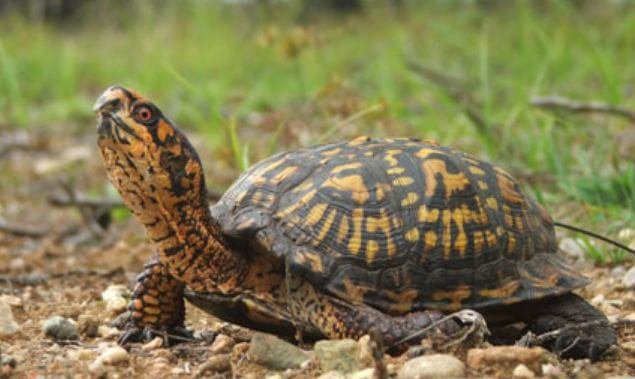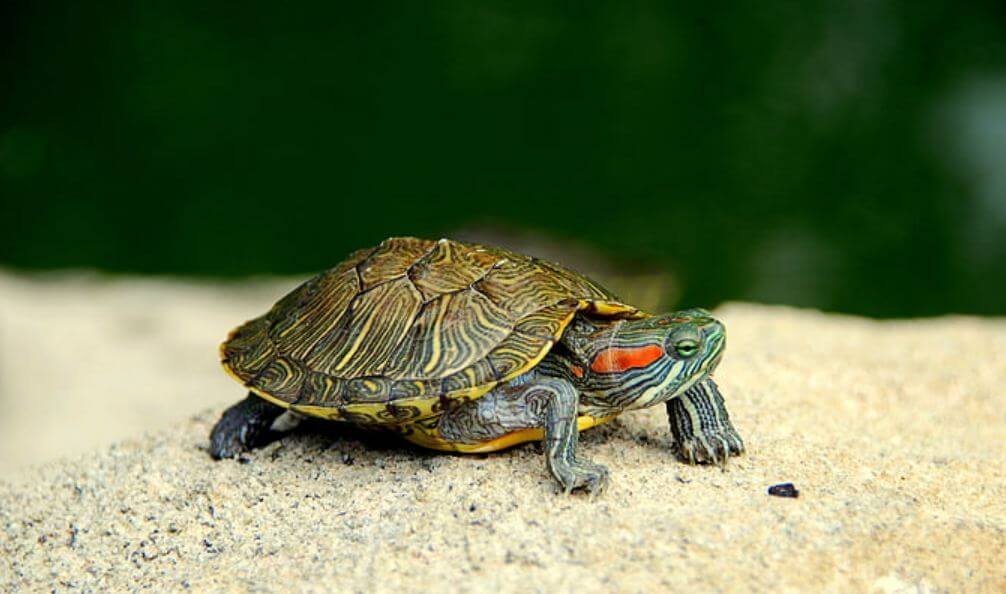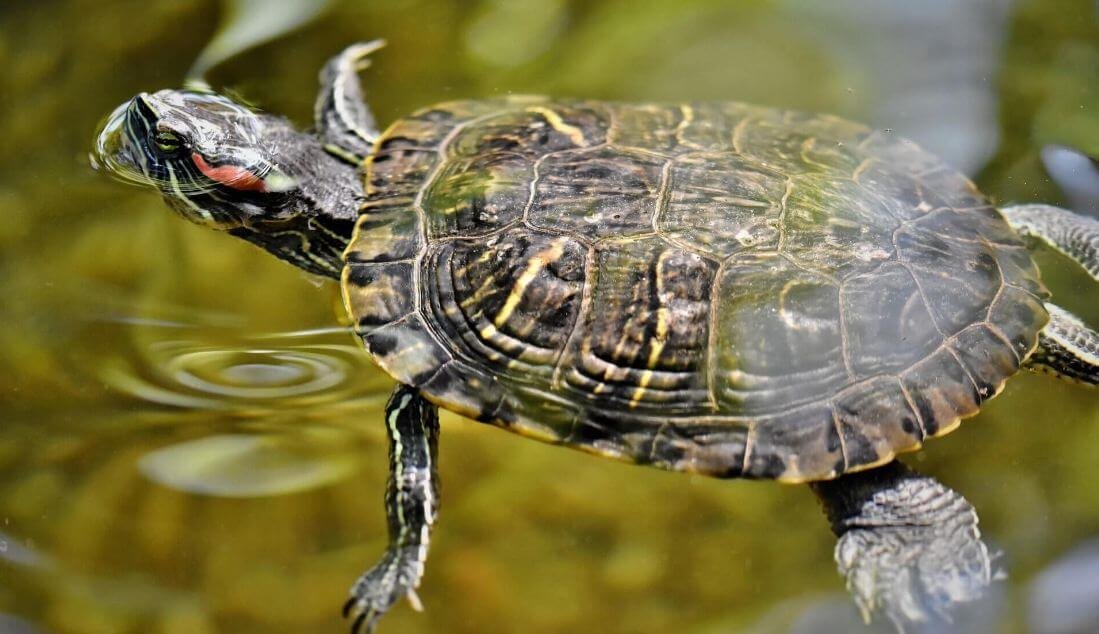Pond turtles are amazingly cute – and who denies the excitement of befriending these endearing animals! And feeding them is the right way to make a harmonious bond with these lovable creatures.
Since pond turtles are omnivores, therefore they open up for a variety of diets. However, not to forget there exists distinct types of pond turtles – so while feeding pond turtles rightly you must be cautious of their specific eating habits.
Here in this guide, we have listed all the necessary information – so that you don’t miss choosing healthy bites for these adorable beings. So let’s explore what do turtles eat in a pond:
Contents
What Do Pond Turtles Eat?
As mentioned above, pond turtles are omnivores – this means they are well-adapted with the characteristics of both herbivores and carnivores.
Basically, carnivores are animals with eating patterns that consume meat – this includes eating the flesh of other animals that are comparatively smaller. Whereas herbivores are animals that rely on plants as their food i.e. they don’t eat other animals.
And yes, coming to what do pond turtles eat – they are good to eat both meat-based and plant-based foods. Understanding the right food for pond turtles, we can look at their habitat.
Related Post: What Do Ducks Eat In A Pond?
Since turtles are cold-blooded animals, they inhabit freshwater and saltwater habitats. Where they can live in either deep or shallow water – however, they are good to spend more time on the shorelines for warmth and sunlight.
According to the habitat adoption of turtles their typical meat-based diet includes small fishes, frogs, snails, slugs, insects, and other small marine animals – whereas, the typical plant-based diet includes aquatic plants, algae, fallen fruits and leaves, green leafy plants, vegetables such as lettuce, cucumber, carrots, spinach and cabbage, and fruits such as apples, melons, and berries.
However, when you see a turtle in a pond, you must not go right away to feed them with any of their general diet items. This is because wild turtles are found in a big variety of species, and with this their diet patterns are different. So, let us understand the eating habits of wild turtles in the pond:
What Do Wild Turtles Eat?

As discussed above, getting aware of the type of wild turtle is necessary to feed them right.
As we know, the diet of wild turtles is varied – however, there are more than 350 species of wild turtles.
The specific type such as the species, size, and age makes a difference in what to feed turtles in a pond.
In general wild turtles are well-adapted to offer different patterns of diet – i.e. they accept the general plant-based items such as:
- vegetable i.e. cabbage, cucumber, spinach, carrots, fallen leaves, green leafy veggies
- fruits i.e. apples, bananas, pears, grapes, kiwis, melons, strawberries, papaya, raspberries, and figs, also fallen fruits.
- aquatic plants i.e. water lilies, duckweed, and algae
Also, their meat-based diet includes:
- crayfish, tadpoles, pond snails, frog eggs, dead or sick fish, and small marine animals found on shorelines
- crickets, mealworms, earthworms, cockroaches, small land insects that can be prey to wild turtles
- mosquitoes, water striders, and small insects that live on the water surface
Having known the typical diet of wild turtles is not enough to feed them rightly – this is mandatory to bother if the turtle in a pond is of what type according to its species, size, and age. So let us dig deeper.
Related Post: What Do Catfish Eat In A Pond? 05 Best Catfish Foods
Types of Turtles: What to Feed Them?
As discussed, with the massive variety of wild turtles their size and eating habits may differ accordingly. Moreover, while feeding a pond turtle, small baby turtles’ diet is not the same as of an adult turtle. So, let us learn more about types of turtles according to their species, size, and age.
Baby Wild Turtles

Generally, baby wild turtles require a healthy protein-based diet as compared to a grown adult turtle. This means, that when you see baby wild turtles in a pond, you should choose to feed them with small insects. However, if you don’t find it easy to catch insects for them, don’t worry they are good to catch them on their own – just make sure you feed a very little amount of plant-based foods.
Wild Box Turtles

Wild box turtles also known as box tortoises are found in North America. Being land turtles their diet is a little different from water turtles. They eat:
Insects such as crickets, mealworms, earthworms, and grasshoppers.
The veggies in their diet include squash, okra, green beans, collard greens, carrots, peas, and green leafy vegetables.
Whereas, they can eat fruits such as bananas, cherries, raspberries, peaches, mango, pears, melons, apples, blackberries, plums, and mulberries.
Wild Water Turtles

Water turtles have different diet patterns as compared to land turtles. The general food items for wild turtles include:
Aquatic plants such as water hyacinth, duckweed, water lettuce, water lily leaves, water fern, bog moss, and algae
Aquatic animals such as crayfish, tadpoles, pond snails, frog eggs, dead or sick fish, small fishes and small marine animals found on shorelines and mosquitoes, water striders, dragonflies, and small insects that live on the water surface
Vegetables such as cabbage, cucumber, spinach, carrots, fallen leaves, green leafy veggies
Fruits such as apples, bananas, pears, grapes, kiwis, melons, strawberries, papaya, raspberries, and figs, also fall.
Wild Snapping Turtles

As the name says these are water turtles with an extremely aggressive nature – so you must not touch them or they will bite you. The eating pattern of snapping turtles is more carnivorous therefore they need to have more meat-based items in their diet and fewer plant-based items. The food items for snapping turtles are the same as the general food items for wild water turtles.
Wild Painted Turtles

Painted turtles coming with enchanting colorful patterns are generally omnivores in nature, therefore unlike snapping turtles these need a balanced diet of plant-based and meat-based items. The food list for painted turtles is the same as mentioned in the general food items for wild water turtles.
Wild Red-Eared Slider Turtles

Red-eared slider turtles are the most popular turtles in the United States. These are most commonly chosen as pets because of their committed lifespan of 20 years. These are omnivorous in nature, which means they require a balanced combo of plants and meat-based items in their diet. The food list for red-eared slider turtles is the same as mentioned in the general food items for wild water turtles.
Foods That Are Bad For Pond Turtles:

In the haste of making an empathetic bond with pond turtles, you must never mess with their diet choice. Food that is indigestible to them can be dangerous for them. Here are some commonly misinterpreted food items that are sure to be avoided while feeding pond turtles:
Oily Food
Pond turtles including wild turtles of any kind are not good with oily food. Therefore processed food with oil is not suitable for them. Best food items for pond turtles include fruits and veggies, small fishes as prey or dead, small marine animals, aquatic plants (same as the food list of wild water turtles), and land turtles (same as food items for wild box turtles).
Dairy Products
Dairy products are not digestible by turtles – feeding with dairy products can be seriously harmful to them. Items such as milk chocolate, biscuits made with milk and carbohydrates, etc must be avoided while feeding pond turtles.
Sugar Products
Like oily and milk products, pond turtles’ digestive system doesn’t include enzymes for digesting sugar. Therefore, foods that include sugar, carbohydrates, milk, oil, etc must be avoided when choosing a healthy diet for pond turtles.
Safety Measures While Feeding Turtles:
The mesmerizing beauty of nature as portrayed by the alluring colors and patterns of turtles must call you to hold one in your hands, have some lovely moments of love, and give them the food you eat!
However, for the gesture of love you need to take care of what suits them best and also what might harm you being incautiously compassionate. Here is what you need to be careful of while sharing your love with pond turtles:
Sharing Food with Turtles
Though you might love to let the pond turtle have some compassionate bites from your food – but beware! Some food might be life-threatening to them. So you must not share your food with turtles if it is not a fruit and veggie as listed in the food items for pond turtles. However, you can share cooked meat with no seasoning and chopped into smaller pieces.
Kissing Turtles
Wild turtles in ponds may carry harmful bacteria that can make you seriously sick. Therefore, you must NOT touch or kiss them. The bacteria such as salmonella are most commonly carried by wild turtles, and getting in contact with these harmful bacteria can be dangerous for your health.
Feeding With Dirty Hands
The way wild turtles’ skin carries harmful bacteria, your dirty hands also carry harmful bacteria that can make turtles sick. Therefore, you must wash your hands properly, and feed them with clean hands to make sure they get the right healthy bites.
Frequently Asked Question [FAQs]

1) Can We Feed Bread To Pond Turtles?
Bread contains carbohydrates, and pond turtles cannot digest carbohydrates because their digestive system is not like humans. Therefore while feeding pond turtles, you must not feed them with bread.
2) Can We Feed Strawberries To Turtles?
Pond turtles that are omnivores in nature love to eat strawberries in a balanced proportion with meat-based items. However, pond turtles with more carnivorous nature should be given less amount of fruits such as strawberries.
3) Can Wild Turtles Eat Lettuce?
Lettuce and all green leafy veggies are perfect for pond turtles. However, for baby wild turtles and for turtles with more carnivorous nature (snapping turtles) fewer amount veggies and fruits must be chosen. Baby wild turtles require more protein as meat-based products in their diet.
4) Is It Ok To Feed Apple To Pond Turtles?
Feeding an apple to a pond turtle is completely fine – however, make sure to give small bite-sized pieces, and don’t forget to remove the skin. Also, baby wild turtles don’t need many fruits and veggies in their diet, therefore they need to be given less amount of apples.
5) Can Wild Turtles Eat Spinach?
Spinach is a green leafy vegetable with any green leafy vegetable is definitely a good diet for pond turtles. However, the type of turtles such as snapping turtles with more carnivore nature and baby turtles requiring more meat in their early diet must be given fewer fruits or veggies such as spinach in their diet.
Summing Up
Conclusively, feeding pond turtles include a variety of options with proper knowledge of their types and their digestive capability. As we have seen you may choose the best option from the food items – such as small insects, small marine animals, for their healthy feeding – also you can give aquatic plants (water hyacinth, duckweed, water lettuce, water lily leaves, water fern, bog moss, and algae), and fruit (apples, bananas, pears, grapes, kiwis, melons, strawberries, papaya, raspberries, and figs, also fallen fruits) and veggies (cabbage, cucumber, spinach, carrots, fallen leaves, green leafy veggies).
Moreover, don’t forget to peel off the skin of fruits and veggies and cut them into small bite-sized pieces while feeding pond turtles. On the other hand, while sharing your compassion and empathy with wild turtles, don’t dare to kiss them or touch them else the bacteria carried by their skin can cause you to be fatally ill.
Have fun feeding the pond turtles!




